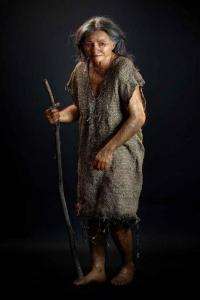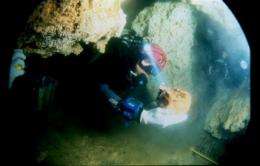Ancient woman suggests diverse migration

A scientific reconstruction of one of the oldest sets of human remains found in the Americas appears to support theories that the first people who came to the hemisphere migrated from a broader area than once thought, researchers say.
Mexico's National Institute of Anthropology and History on Thursday released photos of the reconstructed image of a woman who probably lived on Mexico's Caribbean coast 10,000 to 12,000 years ago. She peeks out of the picture as a short, spry-looking woman with slightly graying hair.
Anthropologists had long believed humans migrated to the Americas in a relatively short period from a limited area in northeast Asia across a temporary land corridor that opened across the Bering Strait during an ice age.
But government archaeologist Alejandro Terrazas says the picture has now become more complicated, because the reconstruction more resembles people from southeastern Asian areas like Indonesia.
"History isn't that simple," Terrazas said. "This indicates that the Americas were populated by several migratory movements, not just one or two waves from northern Asia across the Bering Strait."
Some outside experts caution that the evidence is not conclusive.
Ripan Malhi, assistant professor of anthropology at the University of Illinois, said that "using facial reconstructions to assign ancestry to an individual is not as strong as using ancient DNA to assess the ancestry of the individual, because the environment can influence the traits of the face."
"All of the current genetic evidence points to Northeast Asia as the main source for Native Americans," Malhi said.
However, there have been few opportunities to use DNA or other methods to identify the origins of the first inhabitants because only a handful of skeletons from 10,000 years ago have survived.
The female is known as "La Mujer de las Palmas," or "The Woman of the Palms," after the sinkhole cave near the Caribbean resort of Tulum where her remains were found by divers and recovered in 2002.

Because rising water levels flooded the cave where she died or was laid to rest, her skeleton was about 90 percent intact. Archaeologists and physical anthropologists calculated she was between 44 and 50 years old when she died, was about 5 feet (1.52 meters) tall and weighed about 128 pounds (58 kilograms).
Experts also measured skull features and calculated the muscle and other tissue layers that once covered her face, which served as a guide for experts in paleo-anthropological modeling at the Atelier Daynes in France to complete a model of the woman.
The model shows a stocky woman and clad in a simple knee-length woven tunic. She had a broad face, prominent cheeks, thin lips, and little trace of the epicanthic eye-folds that characterize many modern Asian populations.
"Her body structure, skin and eyes are similar to the population of Southeast Asia," the institute said in a statement.
Susan Gillespie, an associate professor of anthropology at the University of Florida, noted that while the Bering land bridge theory still has a lot of support, "the situation is messier than the straightforward scenario ... of big-game hunters chasing woolly mammoths over the exposed `Bering bridge' to Alaska."
"Recently there has been more serious inquiry into the various origins of migrants, modes of transportation, and dates of when they got here," Gillespie said in an e-mail message. "Dates for peopling of the Americas have been pushed way back, and with the finding of very early skeletal remains, the genetic/skeletal linkages to peoples of northeast Asia has become more cloudy."
But Gillespie cautioned against comparing a reconstructed face from 10,000 years ago to modern populations in places like Indonesia, which have also probably changed over 10 millennia.
"You have to find skeletons of the same time period in Asia, or use genetic reconstructions, to make a strong connection, and cannot rely on modern populations," she wrote. "Do we have any empirical data on what Southeast Asian women looked like ... 10,000 years ago?"
©2010 The Associated Press. All rights reserved. This material may not be published, broadcast, rewritten or redistributed.













